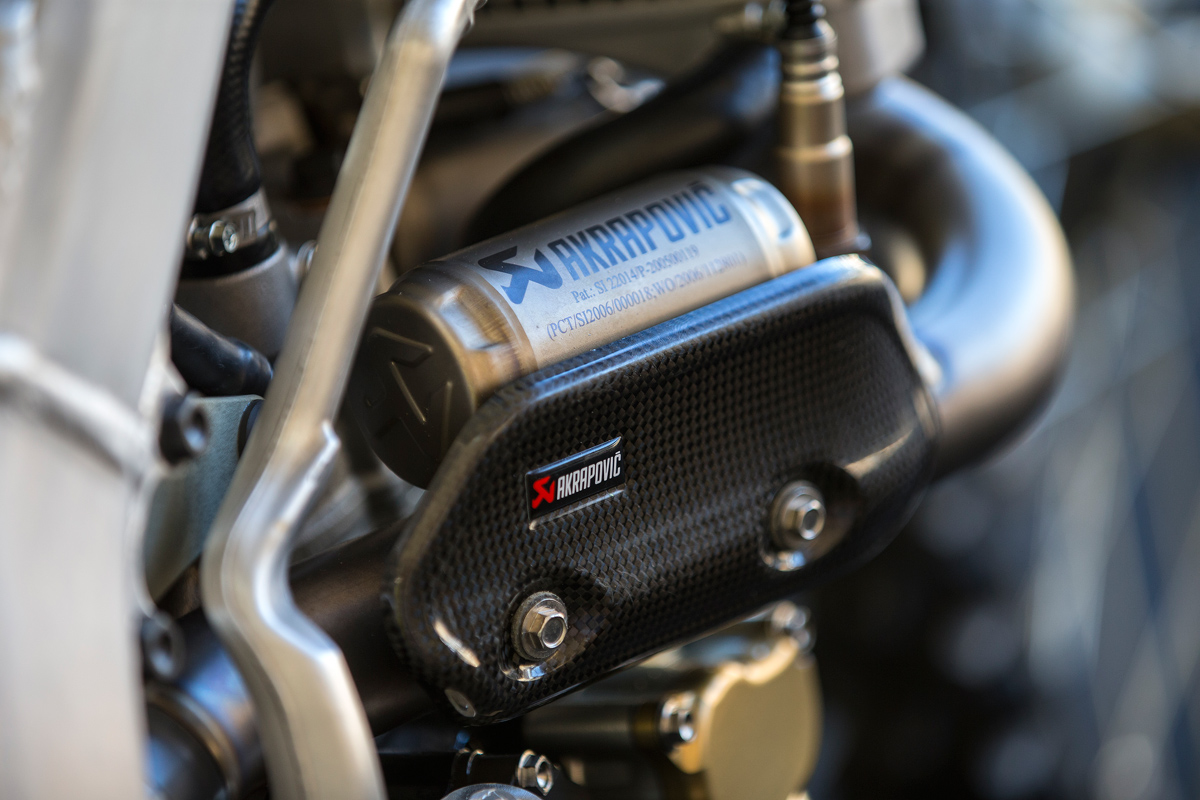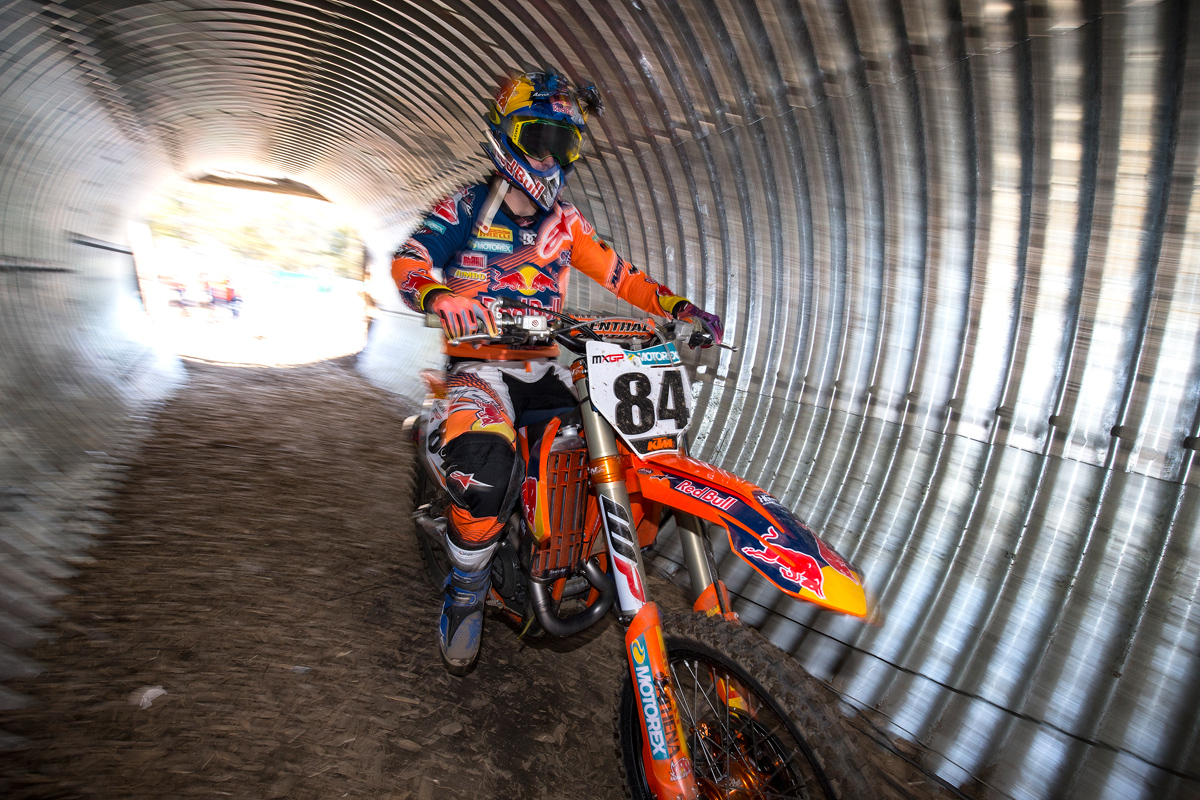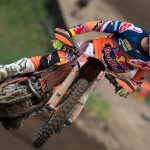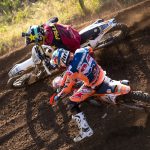The jump from MX2 to MXGP: how big a deal is it? The premier class means ‘another level’ of experience and pedigree but actually manhandling the factory bikes and touching boundaries of personal and technical performance: what does that entail? In a quest for answers we asked the two athletes who thundered into MXGP with emphatic and immediate results as rookies – 2015 and 2016 World Champions Romain Febvre and Tim Gajser respectively – as well as other Grand Prix winners or podium finishers who’ve had to twist their minds and mettle to the challenge.
The dimensions of a 250cc four-stroke motorcycle used in the MX2 class of the FIM Motocross World Championship are remarkably similar to the 450cc fire-breathers seen in MXGP. Variation in the weight of the actual race bikes is negligible – a couple of kilos – and many OEM models actually share a wealth of components when it comes to chassis, subframe, geometry and other parts between the two bikes. Even the lap-times are close on some tracks between the categories. Demographics of MX2 and MXGP aside (the smaller division focusing much more on up-and-coming talent and with an age ceiling of 23 years), pushing these motorcycles to the limits on Grand Prix tracks requires a very different approach.
Watching from the fences or behind an LED screen it can be hard to appreciate the physical, mental and technical demands. Anyone who has ridden a stock 250 and then tried a 450 will know instantly that feeling of inertia and increased sensation of weight, and how the machine needs to be handled accordingly with the extra power on tap. Finding the extra tenths on a 1.6km racetrack in arguably the hardest MXGP field this century is a major mission. “I enjoy the 450…but the competition is different,” reveals Red Bull KTM Factory Racing’s three-times MX2 world champ Jeffrey Herlings; at 22 looking to be the third debutant to rule in MXGP but somewhat hindered by a broken hand just one week before the opening round in Qatar. “In MX2 you might have four-four fast guys but in MXGP there are fifteen. The guy who is in tenth can win a moto and the guy in sixth is still a championship threat. You need a different mindset. If I was injured in MX2 then I’d still think about going to a GP and trying to win; here there is no point in going at all! You need to be 100% just to think about the top ten. You need to be 100% to put that bike where you want it.”

You got the style…
Tim Gajser, Team HRC, 2015 MX2 World Champion, 2016 MXGP World Champion: Two completely different bikes and two completely different styles. With the 250 you have to rev the bike, ride in a lower gear and with the 450 you have to be smooth and respect it because it can hit you so hard! You have to know how to handle it and for me it was not such a big change moving from MX2 to MXGP because I was training a lot with my Dad on the bigger bike. The transition was not so difficult. Now with a second winter under my belt with the 450 I feel even better and having the same bike for practice and racing makes life easier.
Jake Nicholls, MX2 podium finisher, three seasons in MXGP: There is a massive difference and mainly with how hard you can ride the bikes. Right now I’d get back on a 250 and ride so well; I raced ten years on a 250 four-stroke and was so accustomed to being hard and aggressive on the gas, a bit of clutch and go. With the 450s you cannot be like that otherwise the clutch will just burn out; you need to pull it in to control the thing.

Jeffrey Herlings: The 250 needs to be revved and you need to push it to go fast but sometimes on the 450 you are going fast even when you cannot hear the bike! The torque is way-different: on a 250 up quite high and then on the 450 bottom-to-middle. It’s hard; you’ll be in a race situation and be thinking ‘get on the gas!’ but you cannot.
Arnaud Tonus, Wilvo Yamaha, MX2 Grand Prix winner and MXGP debutant in 2017: I spent my whole career on a 250 and you can push the limit all the time and find the balance; this takes some time to find on the 450.
Herlings: It is different. Even though the weight is only a few kilos it feels far heavier. A 250 has a lot less power so you can ride it differently and be a lot more on the gas, with a 450 I tried riding that way once and it turned out with a broken hand. I wouldn’t advise racing it like a 250! You can do it…but there is a big chance of going down. I think a lot of the injuries in the last few seasons in the MXGP class have come just because the bikes are so powerful; they are so fast. Not being able to use the 250 style means you are riding differently…and that needs a different set-up. On the 250 I was always hanging on the back and was wide-open. No chance for that on the 450 so I had to make some adjustments.
Glenn Coldenhoff, Red Bull KTM, MX2 Grand Prix winner, MXGP Grand Prix winner: I think every team is looking for as much power as possible with the 250…whereas in MXGP people are searching for something that will handle. The bike almost weighs the same but the 450 feels heavier; I don’t think Jeffrey wouldn’t have crashed the way he did in Italy with a 250.
Nicholls: I was a very aggressive 250 rider and some others were not. Romain [Febvre] is an example. His style was aggressive but he was not hard on the throttle, the controls or the bike. So his transition to MXGP was a bit easier. So it depends on your style. There was also a ‘smoothness’ to the way I rode the 250 so I thought I’d change across well…but in the end I still had to adjust a lot. Being too aggressive with the controls on a 450 just makes the bike light-up.
Romain Febvre, MX2 Grand Prix winner in 2014, MXGP World Champion in 2015: Compared to some riders I think I have a good balance. I am aggressive but not too much and I’m not lazy on the bike. This helped moving to the 450. Changing your style takes time and it is difficult. We tried this a bit last year after my injury [concussion at the British Grand Prix] and having a different engine for a few races to get starts to put us right at the front. We were struggling a bit with the starts and we knew we could get the bike ready to take holeshots every weekend but there was little point if I couldn’t ride thirty minutes with it. It was difficult to make a good bike for both of the riders.
To read the rest of the story in OTOR simply click HERE
Photos by Ray Archer








